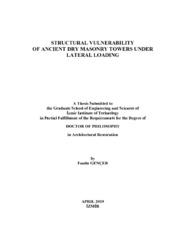Please use this identifier to cite or link to this item:
https://hdl.handle.net/11147/7420Full metadata record
| DC Field | Value | Language |
|---|---|---|
| dc.contributor.advisor | Turan, Mine | - |
| dc.contributor.author | Gençer, Funda | - |
| dc.date.accessioned | 2019-12-03T09:01:16Z | |
| dc.date.available | 2019-12-03T09:01:16Z | |
| dc.date.issued | 2019-04 | - |
| dc.identifier.citation | Gençer, F. (2019). Structural vulnerability of ancient dry masonry towers under lateral loading. Unpublished doctoral dissertation, Izmir Institute of Technology, Izmir, Turkey | en_US |
| dc.identifier.uri | https://hdl.handle.net/11147/7420 | - |
| dc.description | Thesis (Doctoral)--Izmir Institute of Technology, Architectural Restoration, Izmir, 2019 | en_US |
| dc.description | Includes bibliographical references (leaves: 172-180) | en_US |
| dc.description | Text in English; Abstract: Turkish and English | en_US |
| dc.description.abstract | In the Antiquity, masters constructed dry masonry towers that were resistant to earthquake potential of their sites. Determination of the authentic characteristics, that play role on structural behavior, developed in antiquity should be the first step of conservation planning. This study aims to identify the structural behavior of dry masonry towers under lateral loading in relation with their characteristics so that decision making phase regarding their restoration projects can be supported. Dry masonry towers in ancient Caria, Pamphylia and Cilicia, which have different ground accelerations, are examined. Methodology of the study consists of documentation of six case studies with traditional methods, design of hypothetical towers, impact analysis of towers with quasi-static tilt technique, examination of results in terms of collapse angle and failure mechanisms, discussion with the help of the statistical approach, and proposal of a framework for vulnerability rankings and possible failure mechanisms. As a result, parameters effecting structural resistance in the order of high impact to low are staggering ratio, stone depth, ratio between block length and height, proportional relationship between height and length, opening area, number and position and even distribution of header stones. These parameters have impact on each other; so, sustaining of the qualities regarding all of them should be undertaken in their conservation. Furthermore, it is seen that there was awareness of the necessity for usage of different anti-seismic parameters in different earthquake regions. However, appropriate combination of parameters with each other were not always undertaken possibly because of limitations of local materials, budget, time or masters. | en_US |
| dc.description.abstract | Antikçağ’da, ustalar bulundukları yörenin deprem riskini dikkate alarak dayanıklı kuru yığma kuleler inşa etmeye çalışmışlardır. Yapı davranışında rol oynayan, antik dönemde geliştirilmiş özgün özelliklerin belirlenmesi koruma çalışmalarının planlanmasında ilk adım olmalıdır. Bu çalışma, yapı özellikleri bağlamında kuru yığma kulelerin yanal yük altında yapı davranışını özümseyerek, restorasyon projeleri ile ilgili karar alma aşamalarını desteklemeyi amaçlamaktadır. Bu nedenle, farklı zemin ivmelerine sahip antik Karya, Pamfilya ve Kilikya bölgelerinde bulunan kuru yığma kuleler incelenmiştir. Çalışmanın yöntemi, geleneksel yöntemlerle kulelerin belgelenmesi, hipotetik kulelerin tasarlanması, quasi-statik eğme yöntemi ile kulelerin etki analizinin yapılması, analiz sonuçlarının yıkılma açıları ve hasar mekanizmaları açısından incelenmesi, istatiksel yaklaşım ile tartışma ve kulelerin olası hasar görebilirlik derecelerinin ve hasar mekanizmalarının belirlenebilmesi için taslak önerisinden oluşmaktadır. Sonuç olarak, yapısal dayanımı etkileyen parametreler; basamaklanma katsayısı, taş derinliği, taş blokların uzunluk ve yüksekliği arasındaki oransal ilişki, yapının yükseklik ve uzunluğu arasındaki oransal ilişki, boşluk alanı, sayısı ve konumu ve atkı taşlarının dağılımı olarak etkinliklerine göre sıralanmaktadır. Ancak, parametreler birbirlerini etkilemektedir, bu yüzden koruma çalışmalarında yapı özelliklerine ilişkin tüm niteliklerin sürdürülmesine dikkat edilmelidir. Ayrıca, çalışma sonucunda farklı deprem bölgelerinde farklı sismik parametrelerin kullanılmasının gerekliliği konusunda farkındalık olduğu görülmüştür. Fakat, yerel malzemelerin, bütçenin, zamanın ya da ustaların sınırlamaları nedeniyle, parametrelerin her zaman birbirleriyle uygun şekilde ilişkilendirilemediği tespit edilmiştir. | en_US |
| dc.format.extent | xvii, 274 leaves | - |
| dc.language.iso | en | en_US |
| dc.publisher | Izmir Institute of Technology | en_US |
| dc.rights | info:eu-repo/semantics/openAccess | en_US |
| dc.subject | Dry masonry towers | en_US |
| dc.subject | Hypothetic towers | en_US |
| dc.subject | Earthquakes | en_US |
| dc.subject | Caria Region | en_US |
| dc.subject | Pamphylia Region | en_US |
| dc.subject | Cilicia Region | en_US |
| dc.title | Structural Vulnerability of Ancient Dry Masonry Towers Under Lateral Loading | en_US |
| dc.title.alternative | Antik Kuru Yığma Kulelerin Yanal Yük Altında Yapısal Hasar Görebilirliği | en_US |
| dc.type | Doctoral Thesis | en_US |
| dc.institutionauthor | Gençer, Funda | - |
| dc.department | Thesis (Doctoral)--İzmir Institute of Technology, Conservation and Restoration of Cultural Heritage | en_US |
| dc.relation.publicationcategory | Tez | en_US |
| dc.identifier.wosquality | N/A | - |
| dc.identifier.scopusquality | N/A | - |
| item.openairecristype | http://purl.org/coar/resource_type/c_18cf | - |
| item.languageiso639-1 | en | - |
| item.openairetype | Doctoral Thesis | - |
| item.grantfulltext | open | - |
| item.fulltext | With Fulltext | - |
| item.cerifentitytype | Publications | - |
| Appears in Collections: | Phd Degree / Doktora | |
Files in This Item:
| File | Description | Size | Format | |
|---|---|---|---|---|
| T001951.pdf | DoctoralThesis | 35.85 MB | Adobe PDF |  View/Open |
CORE Recommender
Page view(s)
288
checked on Mar 31, 2025
Download(s)
290
checked on Mar 31, 2025
Google ScholarTM
Check
Items in GCRIS Repository are protected by copyright, with all rights reserved, unless otherwise indicated.